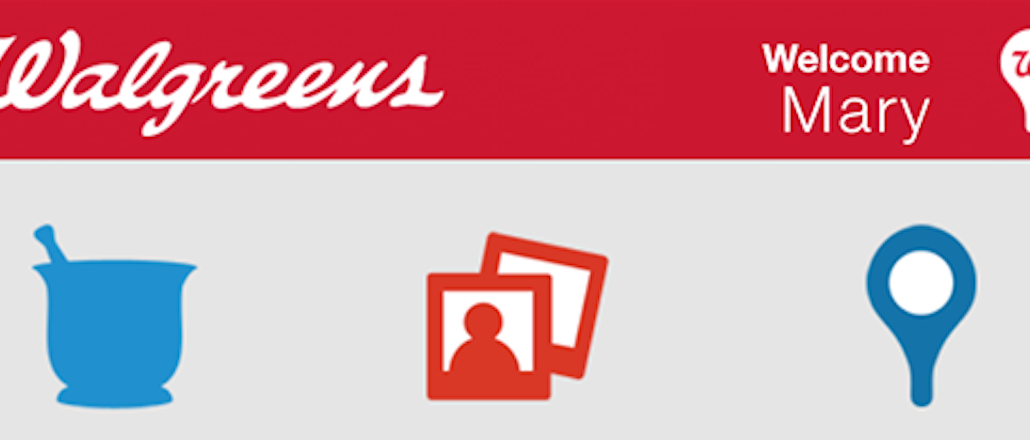
Walgreens pretty much has the country covered. In fact, three out of four Americans have one of the pharmacy chain’s stores within five miles of their homes.
That means Walgreens, like many retailers, is looking to digital as a vehicle for improving the in-store experience — and getting people to buy more. The pharmacy’s digital strategy is anchored around convenience: Its app lets customers navigate snacks and sinus meds with in-store product searches, clip and save coupons, and fill prescriptions with a few taps, all on mobile.
While Walgreens doesn’t disclose how many active users its app has, it’s consistently ranked in the top 10 lifestyle apps on iOS and Google Play, according to app rating tool AppAnnie.
“Offline and online have blurred in the minds of consumers, so almost everything we do digitally ties back to stores in some way,” said Adam Crouch, director of Walgreens’ digital commerce product management. “We’re figuring out how to use digital to take convenience to the next level.”
The retailer has a team dedicated to infusing the company with a “digital DNA,” he said. Crouch emphasized that Walgreens’ main goal is convenience, and a digital strategy enables the company to be more agile in adapting to new consumer trends, particularly within its app.
Walgreens’ digital strategy, which reaches customers both in stores and out, is aiming to enhance and streamline the shopping experience. Here’s its approach.
Incentivizing customers out-of-store
Crouch said that the out-of-store mobile capabilities serve as a catalyst for bringing customers to the physical locations. By putting product information and inventory and in-app, customizable shopping lists to the forefront, they’re improving the in-store experience before consumers get there.
According to Joe Lazslo, senior director of the IAB Mobile Marketing Center of Excellence, retailers, especially physical ones, need to realize that all shoppers have smartphones in their pockets, and they’re not as dedicated to specific brands and stores as they used to be.
“Having a good mobile presence is important for keeping consumers’ attention on your brand as a retailer, and not giving them an excuse to look elsewhere online,” said Lazslo.
The app also incentivizes shoppers to visit by tracking their health choices. Users can link their Walgreens rewards card to their FitBit or a third-party fitness tracker like RunKeeper in order to get perks for being active. A logged three-mile run, for instance, will translate to Walgreens points that can be used toward purchases.
“That creates an understanding that they’re interested in their customers and keeping them healthy,” said Natalie Be’er, senior interaction designer at Huge. “It’s humanizing, and it builds in-store loyalty.”
Getting customers out the door as fast as possible
Some retailers are trying to figure out how to get customers to spend more time in their physical stores, but Walgreens is trying to get people in and out as quickly as possible.
“We’re rooted in convenience, so we want very little friction,” said Crouch. “That’s what customers want from Walgreens.”
Crouch said the team is using digital tools to eliminate friction where it often builds up: the checkout line. Walgreens was an early adopter of Apple Pay; the mobile app enables paperless coupons by connecting saved digital discounts directly to a customer’s rewards card. When scanned, the discounts will be deducted automatically, getting shoppers out the door faster.
“They’re self-aware about where they sit in their customers’ day and lifestyle,” said Be’er. “It’s great to acknowledge that you as a company aren’t trying to be something you’re not.”
While customers are shopping, they can search for store inventory, map the layout for easy access, and receive messages about in-store offers — which, according to Be’er, is a feature retailers have to be careful about.
“If you have the app, and you’re receiving notifications in store, it works because you’ve opted it,” she said. “It gets hairy when you get a ping from Walgreens because you’ve just walked by. When our devices are always on us, they have to be mindful.”
Improving pharmacy capabilities
A huge part of Walgreens’ digital strategy is centered on the pharmacy. Beyond offering mobile prescription refills and automatic pill reminders, the company wants to use technology to make the interactions more human.
“We want to bring the pharmacist out from behind the counter and make them a person to go to for health advice,” said Crouch.
On the Walgreens app, users can log onto Pharmacy Chat, a messaging service to chat directly with a pharmacist, and ask questions about their prescription. The company built on that service in December when it launched a “telehealth” platform with MDLive, making virtual patient visits possible for those who can’t access a healthcare provider in person.
“It’s pretty clear that the functionality of the app has come from user needs,” said Be’er. “There’s a lot of difficulty when it comes to medication, and Walgreens is using technology to go above and beyond. They’re thinking about the customer.”
More in Marketing

How the MAHA movement influenced food and beverage brands in 2025
The MAHA movement has come to stand for different things in different people’s eyes, depending on which initiatives they most closely follow.

Why Georgia-Pacific is turning its programmatic scrutinty to the sell side
The company is turning its attention to the sell side, zeroing in on the ad tech firms that move inventory for publishers — the supply-side platforms.

Future of Marketing Briefing: Why ‘just good enough’ is generative AI’s real threat to marketers
When characters and mascots are allowed to live inside generative systems, they stop being event-based and start becoming environmental.





